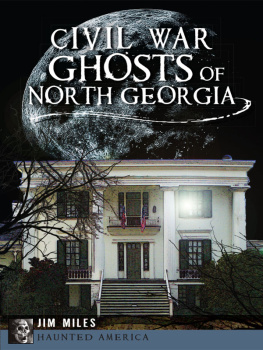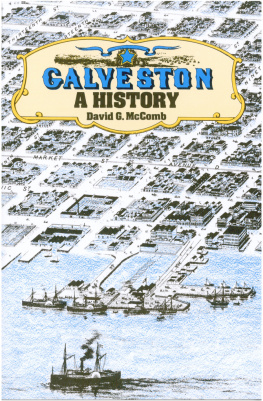

Published by Haunted America
A Division of The History Press
Charleston, SC
www.historypress.net
Copyright 2016 by Kathleen Shanahan Maca
All rights reserved
Front cover: The historic Hotel Galvez, known as the Queen of the Gulf, has kept watch over the waters of Galveston since 1911. Its staff, as well as its ghosts, welcome visitors from all over the world.
First published 2016
e-book edition 2016
ISBN 978.1.62585.740.8
Library of Congress Control Number: 2016938316
print edition ISBN 978.1.46711.965.8
Notice: The information in this book is true and complete to the best of our knowledge. It is offered without guarantee on the part of the author or The History Press. The author and The History Press disclaim all liability in connection with the use of this book.
All rights reserved. No part of this book may be reproduced or transmitted in any form whatsoever without prior written permission from the publisher except in the case of brief quotations embodied in critical articles and reviews.
My endless love and thanks to my husband, John, and my daughter, Kelsey, for their support and patience during the months I spent focusing on spooky stuffmore than usual.
CONTENTS
ACKNOWLEDGEMENTS
I would like to thank all of the Galvestonians who shared their stories and photos with me for this project, including Trish Clason, Boyce Pryor, Jan Johnson, Terry Ritter and Cheryl Jenkines.
Thanks also to Christen Thompson and Julia Turner of The History Press, who were a delight to work with during the process of creating this book.
I am especially grateful for the help of Peggy Dillard, Sean McConnell and Travis Bible from the Galveston and Texas History Center of the Rosenberg Library for their help in locating photos to bring the stories to life.
INTRODUCTION
Galveston Island welcomes over seven million visitors a year, most of whom are drawn to its relaxing beaches, history, shopping and wide variety of cultural entertainments, including one of the largest concentrations of Victorian architecture in the country.
The island also ranks among Americas most haunted destinations, and just about anyone you meet on the island has a ghost story or experience to share.
Before the city was chartered in 1839, the island had already been home to the Karankawa Indians, Spanish and French explorers and countless seafarers, including the infamous pirate Jean Lafitte. In the years that followed, the port city thrived, becoming so prosperous that the mansions of millionaires lined Broadway.
Then a series of tragic events occurred, including the Civil War and repeated yellow fever epidemics. Even so, Galveston grew to become the largest city in Texas in the 1870s and 1880s.
Hurricanes also pounded the coastal city, the worst of which was the Great Storm that struck on September 8, 1900. Killing an estimated six to eight thousand people and obliterating two-thirds of the islands homes and businesses, it remains the worst natural disaster in the history of the United States.
Drastic measures had to be taken to handle the number of corpses that covered the island. Many bodies were buried where they were found, which means that almost any portion of ground walked on today might be a grave.

Merchants in front of the Produce Building, now home of the Old Strand Emporium. Courtesy of the Rosenberg Library, Galveston, Texas.

Damage at Ritters Saloon on the Strand, where the first storm victims died. Courtesy of the Rosenberg Library, Galveston, Texas.

Storm victims being loaded onto barges. Courtesy of the Rosenberg Library, Galveston, Texas.
In the days that followed the storm, men who were drafted into Dead Gangs loaded the bodies into carts and carried them to the Strand to be stacked in temporary morgues. The men who ran the death houses were issued a bottle of whiskey and told to stay with the bodies until they were identified.
Those who remained unclaimed were loaded onto barges, which took the departed out to sea. Just a few days later, however, they washed back ashore, and the situation became desperate.
As a last resort, funeral pyres were lighted across the city. Photos still exist of this process, including one directly in front of the Bishops Palace.
Impossible as it seems, Galvestonians recovered and went on with their lives, but they never forgot.

The bustling Galveston business district, 1910. Authors collection.
People say that spirits can draw strength from water. If that is so, it explains why an island, surrounded by water, is home to so many ghosts. The dead outnumber the living on this island, and many insist on remaining. Theyve always been here and perhaps always will be. Newspaper accounts from the 1860s even describe the ghost of a woman in white that wandered to the piers each night.
The tales of ghosts on the island are too numerous to gather in one book, so Ive conjured a few of my favorites and some new discoveries to share with you here. I hope you enjoy the stories and perhaps visit a location or two to see if you can experience anything yourself.
Do the ghosts of Galveston really exist? Decide for yourself.
H UTCHINGS S EALY B UILDING
232628 STRAND
The preeminent nineteenth-century architect Nicholas Clayton designed this pair of three-story buildings to appear as if they are one. The narrow Ball, Hutchings and Company bank building on the corner and the John Sealy office building next door are an impressive sign of the wealth that was once part of the Wall Street of the South.
Built in 1895 of gray and pink granites, red Texas sandstone and buffcolored terra cotta, they were restored to their former grandeur in 1985. A shield on the west faade is emblazoned with the 1895 erection date, and the firms founding year of 1854 appears below it.
Looking through the glass doors on the Strand side, visitors can see an ornate wrought-iron and slate staircase ascending toward a skylight between the two buildings. It is on this staircase that the woman in white is often seen, although she has appeared in many parts of the two buildings. She is the ghost of a heroic schoolteacher whom locals have named Sara because her true identity has been lost.
During the 1900 hurricane, Sara and others took shelter in these massive buildings. As the storm surge rose along the Strand to seventeen feet, the people climbed to the top floors. Witnesses from the disaster relate the story that the brave teacher selflessly climbed through a window, balanced on the ledge and grabbed people as they floated by in the floodwaters, pulling them inside. Those victims who were already dead were put on one side of the room, and the living were laid on the other. She stayed in the building for several days caring for the sick and injured until she herself succumbed to the disease epidemic that followed the storm.
Next page












